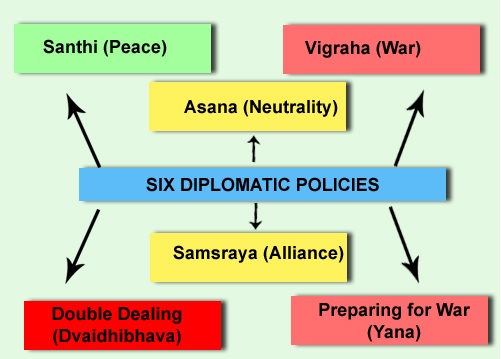
- Chanakya’s Six-fold policy deals with war and peace with the neighbouring states and how a king should assess his power and what actions he needs to take to deal with the states.
- A wise king will scrutinize as to which of the policies he can adopt to take his kingdom toward progress.
- Relating this to the current era where war is the least priority, countries have used the alliance ploys to a greater effect
- Causing unrest among the civilian population, dividing people on religion, caste etc., leading to the economic failure of the country are ploys used to weaken a country
- Applying Chanakya’s policies to emerging world scenarios can open up many more strategies to protect ourselves from foreign intervention
The Arthashastra, meaning a treatise (Shastra) on the anything that helps in creating wealth and prosperity (Artha)*, is a magnificent work that comprehensively describes how a king has to effectively deal with the statecraft, economic policies, and military strategies of his kingdom. The credit of this practical approach of addressing the political and financial issues of the kingdom goes to Kautilya/ Chanakya or Vishnu Gupta (350-275 BC), who was the Prime Minister of the great King Chandragupta Maurya, the founder of the Mauryan Empire.
Let’s see the views of Chanakya in the field of foreign policy during his time (called the Six-Fold Policy in his text). It deals with the topic of war and peace with the neighbouring states and how a king should assess his power and what actions he needs to take to deal with the states. It describes in-depth about the nature of alliances, the peace treaties that can be formed and seeking help or helping other states for their protection.
For now, let us see how Chanakya addresses the logic behind deciding the policy that needs to be adopted by the king based on the state of his kingdom: deterioration (falling economy/ resources), stagnation (profit = loss) or progress (rising economy).
The Six-fold policy
A wise king will scrutinize as to which of the policies he can adopt to take his kingdom toward progress. It involves erecting forts, buildings, roads and highways (infrastructure development), improving agricultural yield, obtain natural resources from mines and forests without hassles and at the same time be able to destroy the similar works of his enemies.
The six-fold policy is as follows:
- Peace (sandhi),
- War(vigraha),
- Neutrality (asana),
- Marching (yaana),
- Alliance (saamarasya) and
- Waging war with one and making peace with another (dvaidhi bhaava).

When the king knows that his army is neither powerful enough to attack the enemy nor can it defend itself from an invader, the king should seek help from superior kingdoms to control any damage and slowly raise the economy (policy of alliance).
However, if the king outrightly believes that his army is full of fierce warriors and the troop is well equipped than the enemy, he can wage a war to conquer his enemy. This should also ensure that the expansion is worth the progress that will happen in future. If the king feels that he needs more resources in case of emergency, he can grow his army in size on the way to his enemy kingdom (policy of marching).
The interesting concepts arise when both the kings of state are of the opinion that the army of both are of equal capacity and involving in a war will only cause deterioration of one’s own kingdom. At this point, the kings have the only option of coming to an agreement (policy of peace through neutrality).
For Peace and Economic Growth
By keeping the peace the king can carry out important productive works in the country, enjoy these profits and also those of the enemy by the virtue of the policy and at the same time destroy slowly such works of the enemy.
Structuring the economic policies in one’s country in a rewarding way with special allowances, tax rebates, dwelling rewards, profit-based bonuses to employees, one can attract more workers from other skilled countries (target immigration from enemy’s country).
At the same time employing spies to another kingdom, one tries to create unrest among those people you are indirectly fuelling the loss of the enemy’s resources.
Next is to apply the policy of alliance with other kings. One can extend the hostility of the enemy with another king (who is my alliance) so that people migrate to one’s kingdom or one’s enemy has to approach for protection from his enemy. Further, with the help of the enemy, one can attack another enemy so that the retaliation is stopped from one end. (policy of dvaidhi bhaava).
All these strategies lead to a point at which either of the kings is helpless or forcibly rendered weak so that one can finally attack and conquer.
Relevance for modern diplomacy

Relating this to the current era where war is the least priority, countries have used the alliance ploys to a greater effect where causing unrest among the civilian population, dividing people on religion, caste etc., leading to the economic failure of the country and causing dependence in the form of loans on richer countries are the outcomes.
Knowing more about these principles of Chanakya and applying them to current and emerging world scenarios can open up many more strategies to protect ourselves from foreign intervention through similar ploys.
(Author is a software engineer in a private IT firm. He is interested in Sanskrit language and loves to understand and interpret Vedic knowledge and adapt the same to modern daily life)
* The word ‘Artha’ can mean differently in varying context. Generally anything that helps in creating wealth and prosperity can be termed as Artha. Ex: for a farmer, his land is the source of income, for a king his kingdom, army is the source of prosperity and expansion. Thus the study of these techniques is called arthashastra.

Nice
The word ‘Artha’ can mean differently in varying context. Generally anything that helps in creating wealth and prosperity can be termed as Artha. Ex: for a farmer, his land is the source of income, for a king his kingdom, army is the source of prosperity and expansion. Thus the study of these techniques is called arthashastra..
Well presented the juxtaposition of the past ant present, mate.
Yes its true that many powerful countries have used the same policies to downsize other countries by dividing them based on caste etc.
Beautifully Explained !! Kudos.
Few of the words and references have been made from the book “Kautilya’s Arthashastra” translated into English by R. Shamasastry.